To Scilly with a sketchbook, and other fragments
When the world seems full of noise and turbulence, anything that is quiet, gentle and creative seems all the more precious. Since last writing, I’ve been to Cornwall for my annual sailing and teaching trip on board Eve of St Mawes (www.classic-sailing.co.uk); I also sailed to Scilly on Eve’s big sister Amelie Rose (http://www.topsail-adventures.co.uk/), where I was doing impromptu sketching lessons with the crew.
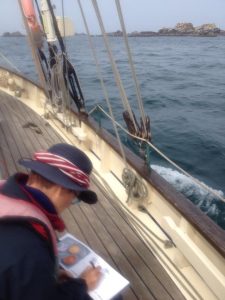
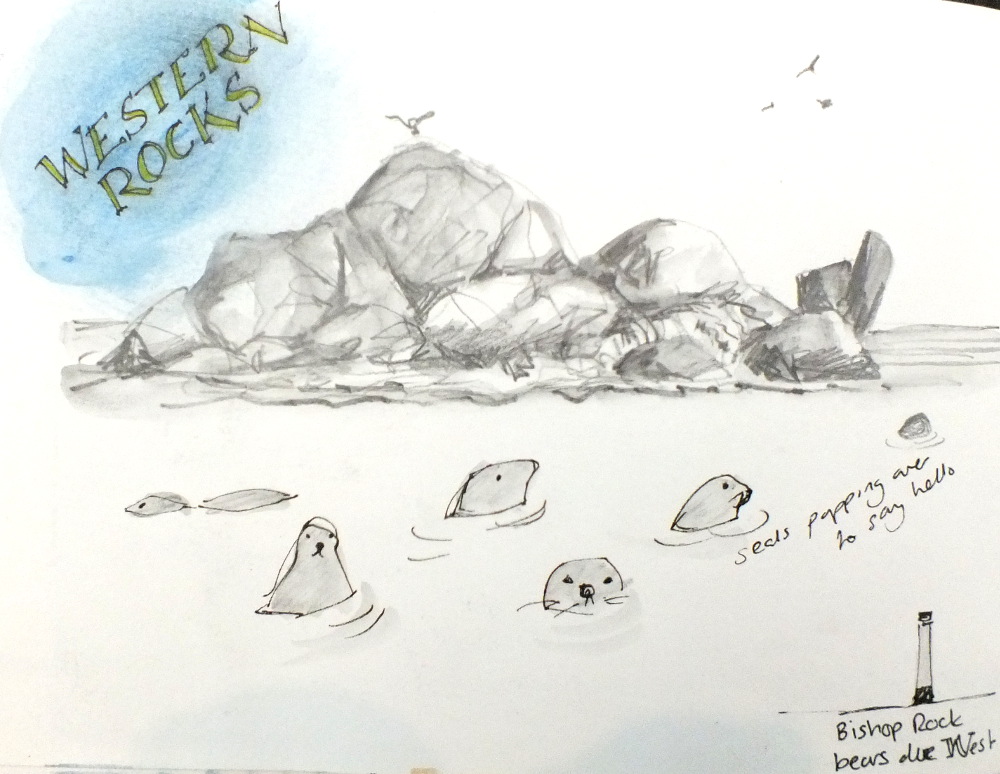


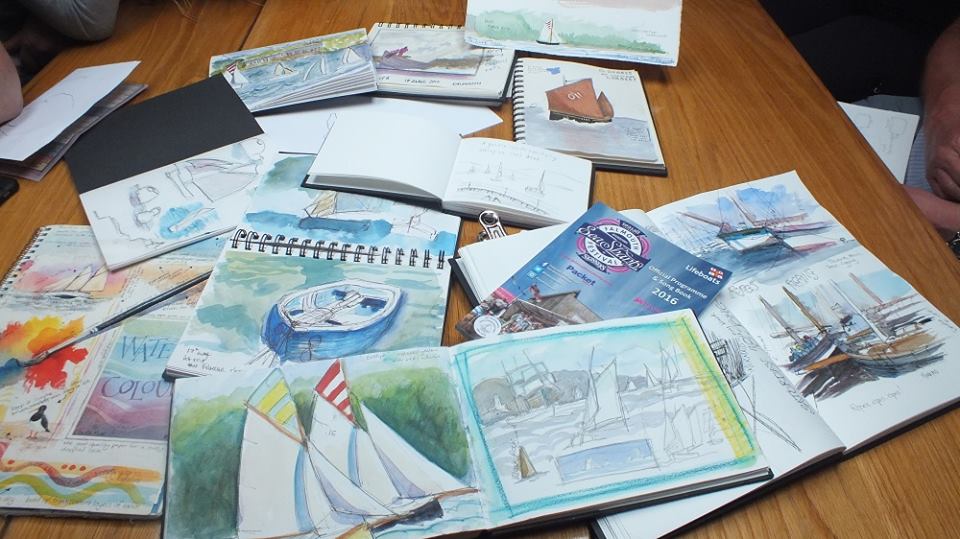
Back in Suffolk with memories of pilot cutters, ketches and luggers still dancing in my head, the time then came to teach a workshop for Art Safari called ‘Where land meets sea’ (www.artsafari.co.uk). This was not so much about drawing boats as drawing anything at all from life. My students confessed that they could do sitting at home copying scenes from photographs, but it seemed a big leap of confidence to getting out there in the real world with an empty page, a world in 3D and members of the public peering over your shoulder.
Drawing from life is challenging but it’s also thoroughly enjoyable, and there’s nothing quite like it for developing your artist’s ‘eye’. I know I’ve gone on about this many times before (see blog post of 24th February – The Sketchbook Voyage) so with a sketchbook full of Scilly island doodles and fast-sailing Falmouth classics, here are a few more tips for outdoor sketching with confidence:
1. Paint a slice of life, from the blues of the sky right down to the deck or the ground at your feet. This is a good warm up exercise and gives you a window into the colours of the day without feeling you have to do lots of complicated drawing. It also helps you to see everything around you as patches of colour rather than ‘things’.
You can if you like try a horizontal ‘slice’, but of course you don’t usually get much as much colour variation this way!
2. Keep your equipment to a minimum. I carry a small hardback sketchbook, tiny paintbox, pencil case with pencils, pens, brushes, and a small pot of water. Passers-by rarely notice what I’m doing or make any comment. You can of course set up an easel and stool and a large canvas – go for the smock and beret as well if you want to – but you just might be a tad conspicuous! There’s nothing wrong that that, but people will come and look over your shoulder.
3. Fill the page with fragments, notes and observations. You can of course fill the page with one complete scene, but you don’t have to. A page full of bits and pieces is likely to have just as much of the essence of the place as a completed painting.
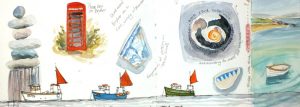
4. Mix words and pictures. Treat your sketchbook like a diary; add notes, dates, places, feelings. Words and pictures are meant to be together. Play around with colour and treat words as part of the pattern if you want to, but even handwritten words make sketches look more interesting.
5. Don’t wait for the perfect scene. Draw anything, anywhere. Draw your shoes, your lunch, the pattern on a carpet, a sunset, the cat, the objects in your kitchen, anything that catches your eye. The more you sketch, the more the world around you will come alive.
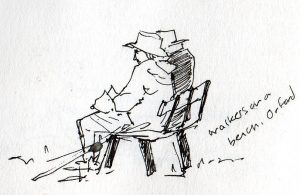
6. Be brave and try to draw people. Sooner or later you’ll need to put people in your sketches. Start by putting them in the distance and then build confidence and put them closer.
Back view is easier than front, and you need less detail than you think.
7. Enjoy the act of drawing and painting, enjoy the feel of the materials and the marks you make. Sketching is a journey of observation and appreciation, it’s not a destination.
I hope this helps – try it and let me know how you get on.
In the meantime it’s back to the drawing board, catching up with business and boat maintenance. I’ll leave you with two book recommendations, both of these on my bunkside reading heap at the moment:
‘Beloved Old Age and what to do about it‘ is Julia Jones’ new book, and my most recent cover design. It’s a curious mix of unpublished Margery Allingham memoir and Julia’s own experience of dementia care; it’s deeply personal and surprisingly uplifting. I recommend it to anyone facing their own or others’ ageing issues and in need of a different viewpoint – for an artist, of course, a different viewpoint presents a completely different scene. I don’t have any elderly relatives of my own (I have hardly any relatives at all) but I was one of Julia’s army of regular visitors /companions/ carers involved in the continuous endeavour to keep her mother June anchored to familiarity as dementia took hold. June has now been moved to a specialist care unit, but inspiration is found in unlikely places, and here’s my little tribute to the time spent with her (https://goo.gl/xDo68W). Julia describes dementia as a ‘shipwreck in slow motion’, and the sailing analogy was inspired by June’s love of the sea (she and her husband owned Arthur Ransome’s boat Peter Duck, now owned by Julia, but that is another story – find out more on www.golden-duck.co.uk.)
My other recommendation by contrast is from the other side of the pond and it’s Elizabeth Gilbert’s ‘Big Magic‘. It’s about how to live a more creative life, not in its narrowest sense of ‘artistic’ but in its broadest meaning of joyfully fully engaged with whatever lights you up. ‘How to’ books are usually fairly dire, spinning out into a whole volume some little nugget of advice that could be dealt with in one sentence, but this one digs deeper. Books are like meals, some are fast food and some give proper nourishment – the best test of a book is how long it stays with you after you’ve finished the last page. A bit like a good song, too. Before I scramble that analogy any further, I’ll finish with Liz Gilbert’s definition of a creative life:
‘When refer to ‘creative living’, I am speaking more broadly. I’m talking about living a life that is driven more by curiosity than by fear (Elizabeth Gilbert)’.
I’m all for that. More curiosity and less fear would make the world a far nicer place (and it’s not a bad way to approach someone with dementia, either!) Bye for now, and stay inspired….

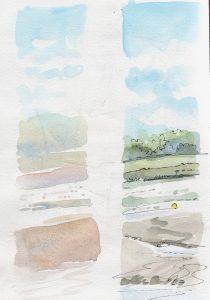
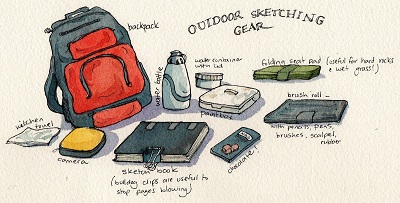


Hi Claudi
Another priceless little piece of artistic wisdom along with a couple of life’s oft forgotten gems. x
Enjoyed reading this Claudia – come back to us soon x
Great post! As a lover of watercolour and classic sail craft, your blog often puts a big smile on my face. 🙂
Great drawing tips, thank you. Any suggestions/recommendations for the colour blind? I have problems with red-green, and didn’t know I had a problem until someone laughed at my painting with brown grass in infants.
Thanks Justin….. colour blindness must be very tricky. One solution would be to stick to tonal work, pencil or pen, or use watercolous in greys and sepias. Black and white photos are usually more atmospheric than colour ones, after all. Another way would be to ask a non colour blind companion to check your colour mixes for you before you put them on, and then make a reference chart of colour mixes to help you get them right. Let me know how it goes!